or?
I have some worn out hoof rasps and want to reuse the metal to make a short blade.
I have not made up my mind and am trying to find more information about the short blade the scythians used.
A striking example is
[ Linked Image ]
and thát, although very interesting, is quite beyond my skills :lol:
Interesting is that quite a lot of the artwork shows complétely different blades looking more like a ´cinquedea´ shape.
The artwork also shows the scabbard strapped to the leg, quite often the ríght. Makes you wonder as the short blades depicted can probably be drawn with the right hand from here but it might just as well be artistic license....
The question if anyone out here has an illustration of an archeologic find?
Thank you,
peter
A friend of mine asked me about scythian blades. He was talking about a picture what he found in an art history book. As I can remember it was a sabre. Tomorrow I will ask him about this.
Crap!
I think I just "reported" your post accidentally, Peter.
My "report" consisted of saying to you that I would try to scan a few sketches and photos for you tomorrow, and asking whether you were interested in early or late stuff.
Sorry!
I think I just "reported" your post accidentally, Peter.
My "report" consisted of saying to you that I would try to scan a few sketches and photos for you tomorrow, and asking whether you were interested in early or late stuff.
Sorry!
Buenas John, and thank you.
I am most interested in (early) iron age (up to Roman period).
Early scythian iron blades were short(er) because the workshops were still accustomed to bronze.
Btw, look at these:
http://www.pitt.edu/~haskins/group9/kuloba15.gif
http://www.pitt.edu/~haskins/group9/kuloba14.gif
Looks like the same guy from both sides :lol:
Striking is:
- no bow&arrow
- short spear
- interesting hilt on appearantly short blade
ánd the obvious fact that this guy could just as well be germanic or celtic
Peter
I am most interested in (early) iron age (up to Roman period).
Early scythian iron blades were short(er) because the workshops were still accustomed to bronze.
Btw, look at these:
http://www.pitt.edu/~haskins/group9/kuloba15.gif
http://www.pitt.edu/~haskins/group9/kuloba14.gif
Looks like the same guy from both sides :lol:
Striking is:
- no bow&arrow
- short spear
- interesting hilt on appearantly short blade
ánd the obvious fact that this guy could just as well be germanic or celtic
Peter
Peter,
Do you think that those rectangular holes in whats left of the blade are evidence of inlays?
Ken Speed
Do you think that those rectangular holes in whats left of the blade are evidence of inlays?
Ken Speed
Bunenas Ken. I have no idea. Piercing of blades is notthonh strange even if is not common. It is a rather insecure solution for inlays too.
Meanwhile, as luck has it, I have found an illustration of something I can aim for and on ebay of all places :blush:
[ Linked Image ]
peter
Meanwhile, as luck has it, I have found an illustration of something I can aim for and on ebay of all places :blush:
[ Linked Image ]
peter
Look under Akinakes.
| Douglas S wrote: |
| Look under Akinakes. |
Beat me to it. Some pics
[ Linked Image ] [ Linked Image ] [ Linked Image ]
Also the much later era Russian Kindjal may be a survival of a very very antique type perhaps going back to the Scythians
[ Linked Image ]
I also bet Manouchers book on Iranian arms and armor probably has some Scythian stuff but I haven't been able to get it yet.
J
Thank you for the suggestions.
I found the illustration on the wiki-page interesting:
[ Linked Image ]
Compare the sword with the ebay one.
The scabbard seems strangely large and this may be the artist representing the leather covered fur lined design.
peter
I found the illustration on the wiki-page interesting:
[ Linked Image ]
Compare the sword with the ebay one.
The scabbard seems strangely large and this may be the artist representing the leather covered fur lined design.
peter
| Peter Bosman wrote: |
| Thank you for the suggestions.
I found the illustration on the wiki-page interesting: [ Linked Image ] Compare the sword with the ebay one. The scabbard seems strangely large and this may be the artist representing the leather covered fur lined design. peter |
That T-shaped pommel seems to be characteristic
| Peter Bosman wrote: |
|
The scabbard seems strangely large and this may be the artist representing the leather covered fur lined design. |
My first impression of the image in question is that the "scabbard" is actually a representation of a bow-case (Gorytos). Some quick looking around provided other such examples, for instance:
[ Linked Image ]
From http://parthia.com/parthia_horses_burris.htm, and also featured in the Osprey book Mounted Archers Of The Steppe by Antony Karasulas, where it is cited as having a built in dagger sheath.
| Eric Meulemans wrote: |
| My first impression of the image in question is that the "scabbard" is actually a representation of a bow-case (Gorytos). Some quick looking around provided other such examples, for instance:
[ Linked Image ] From http://parthia.com/parthia_horses_burris.htm, and also featured in the Osprey book Mounted Archers Of The Steppe by Antony Karasulas, where it is cited as having a built in dagger sheath. |
I assumed he was talking about what looks like a sword hilt to the right of the gorytos.
J
Yes it may be a bowcase.
The ting is you carry the bow the other way around and I thought to recognise blade shape rather than a bow shape in the sheeth.
It mat however áll be artist impression.
It is probably better to look at the very accurate art on golden objects as archeological finds, Herodotus´s text and that art correspond.
Concerning swórds this means it is, in the light of our present day perception of a sword, more apt to speak of daggers.
Anyway; I find it very interesting that the sheath was fixed on the right side. This coïnsides with my perception of the light cavalry way.
I am also very interested in the relativey, measured against our perception of them being born with a horse bow, large number of scytian mouted warriors withoút a bow but with a spear.
Playing around in the saddel with bow and spear I noted (and wrote) that the spear and bow appear to rule eachother out for the rider: you cannot shoot the bow while carrying a spear whereas the bow is a weapon for the larger distance of the two. As even the single gorytus doés get in the way, why then bother?
I am brooding over this... and have made myself a new spear. This time ash, not bamboo so I can compair the two. I have meanwhile also ordered a replica bronze spearhead.
This written I want to remark that there is no ´best´ way or ´best´ weapon: it all depends on the circumstances. I am simply always looking from the horse riders viewpoint and find this highly informative.
Back on topic: I will make the hoof rasp into a a simple stabbing blade.
peter
The ting is you carry the bow the other way around and I thought to recognise blade shape rather than a bow shape in the sheeth.
It mat however áll be artist impression.
It is probably better to look at the very accurate art on golden objects as archeological finds, Herodotus´s text and that art correspond.
Concerning swórds this means it is, in the light of our present day perception of a sword, more apt to speak of daggers.
Anyway; I find it very interesting that the sheath was fixed on the right side. This coïnsides with my perception of the light cavalry way.
I am also very interested in the relativey, measured against our perception of them being born with a horse bow, large number of scytian mouted warriors withoút a bow but with a spear.
Playing around in the saddel with bow and spear I noted (and wrote) that the spear and bow appear to rule eachother out for the rider: you cannot shoot the bow while carrying a spear whereas the bow is a weapon for the larger distance of the two. As even the single gorytus doés get in the way, why then bother?
I am brooding over this... and have made myself a new spear. This time ash, not bamboo so I can compair the two. I have meanwhile also ordered a replica bronze spearhead.
This written I want to remark that there is no ´best´ way or ´best´ weapon: it all depends on the circumstances. I am simply always looking from the horse riders viewpoint and find this highly informative.
Back on topic: I will make the hoof rasp into a a simple stabbing blade.
peter
| Jean Henri Chandler wrote: |
| I assumed he was talking about what looks like a sword hilt to the right of the gorytos.
|
The (second) depicted statue appears to show the rider shooting the bow and...... with the sword in its scabbard on or close to the bow case.
peter
Skythian sword:
 Attachment: 51.08 KB
Attachment: 51.08 KB
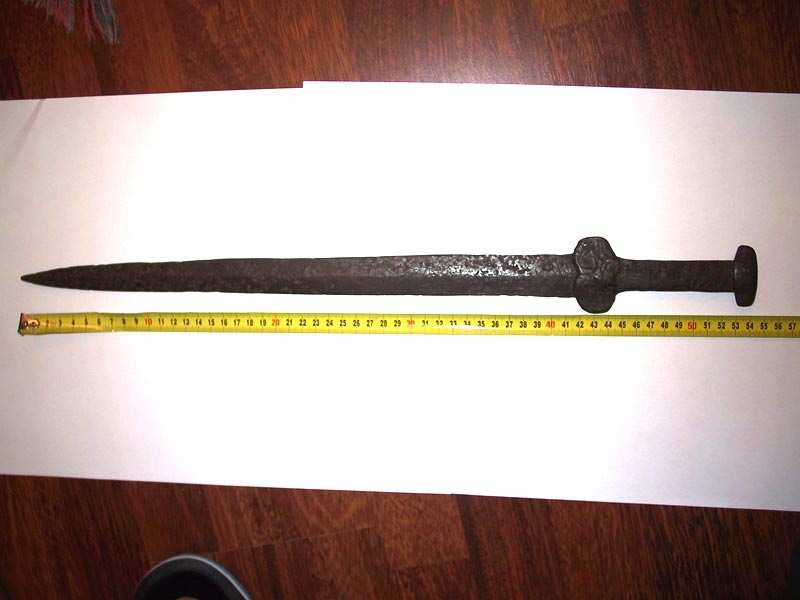

Some swords and daggers. Other than the very fancy type shown most are fairly simple.
 Attachment: 49.69 KB
Attachment: 49.69 KB
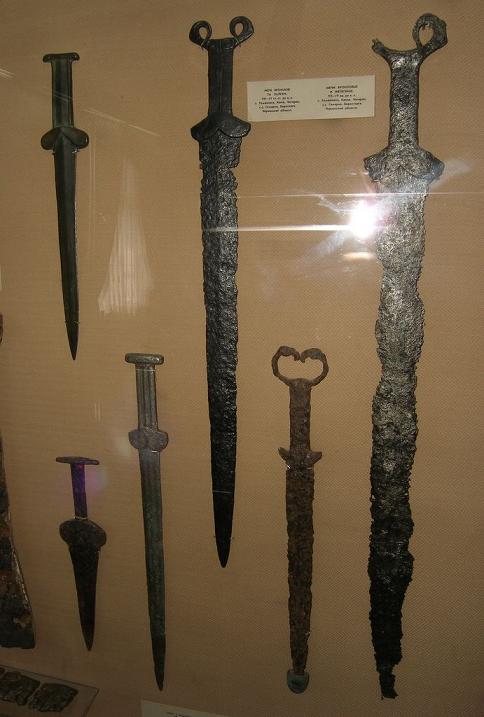

"Two bronze swords of the Scythian type. Paris, C.T. Loo Collection". From The Animal Style in South Russia and China by Rostovtzeff.
 Attachment: 30.2 KB
Attachment: 30.2 KB
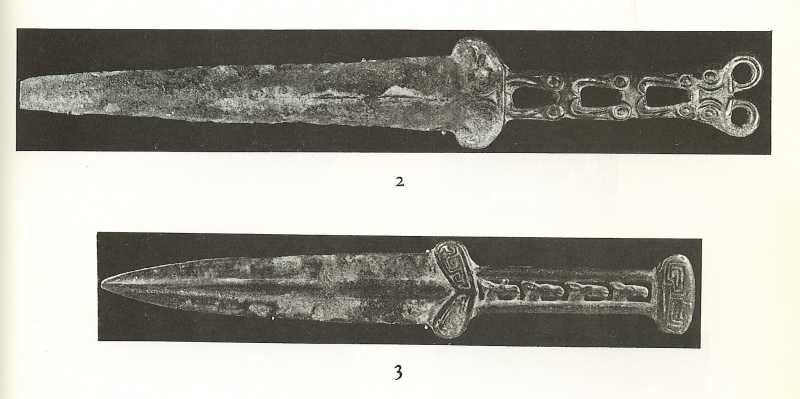

| Peter Bosman wrote: |
| Yes it may be a bowcase.
The ting is you carry the bow the other way around and I thought to recognise blade shape rather than a bow shape in the sheeth. |
Hmm...interestingly, this article: http://www.atarn.org/chinese/scythian_bows.htm mentions that ancient Scythian bows might have been carried in a different way from later Eurasian bows. The straight "blade shape" may actually be arrows stored in arrow-pockets lined up on the outside of the bowcase--again, the article shows the probable configuration for this.
| Lafayette C Curtis wrote: |
| Hmm...interestingly, this article: http://www.atarn.org/chinese/scythian_bows.htm mentions that ancient Scythian bows might have been carried in a different way from later Eurasian bows. |
From a horseman´s view that is quite logical. The scythians rode bareback or with a saddlecloth wich later evolved with pommel and cantle and incorporated wooden strips. This means their ´saddle´ offered very different options during their rise, reign and the shift to other peoples. Thús the goryt would have had to be functional under evolving circumstances and will no doubt have evolved.
There is a huge difference between riding bareback and riding with the later type saddles. It will, and quite letrally, have been a foundation for different weapons and - use of weapons.
I have not yet fully develloped my idea but trying things out on my horses has provided me with quite a bit of food for thought.
The more I find out about it and about the practicallities, the more I get convinced of the role of the beaker people in the domestication of the horse and spreading of the horse mounted warriers. They introduced the horse wherever their culture appears and used the short composite bow. They also moved into asia.
I think it is quite logical the above mentioned rider could just as well have been a germanic warrior.
The ´sword´ as we now see the term will not have been a mounted man´s weapon untill the technical evolution made realy long ones possible. The consequences for the choice and use of weapons is large.
Also, the mounted warrior was a force to be feared far longer befóre long swords became possible than after.
But alas, I am still working on this and at least have a clear idea of what I am going to do with the hoof rasp :lol:
peter
Hi all...
Great thread.
I have a couple of images that may be of interest. The first is a Quiver found in the tholos burial at Vergina... believed to be the tomb of Philip II of Macedon. I have read that some scholars think it may be a gift or trophy from Scythian lands.
The second is a sword published in The Metropolitan Museums work called "The Golden Deer of Eurasia." It is said to date from the 4th century B.C. I am amazed at how the guard has characteristics of later scandinavian swords, particularly Peterson's type Z.
take care
ks
 Attachment: 99.37 KB
Attachment: 99.37 KB
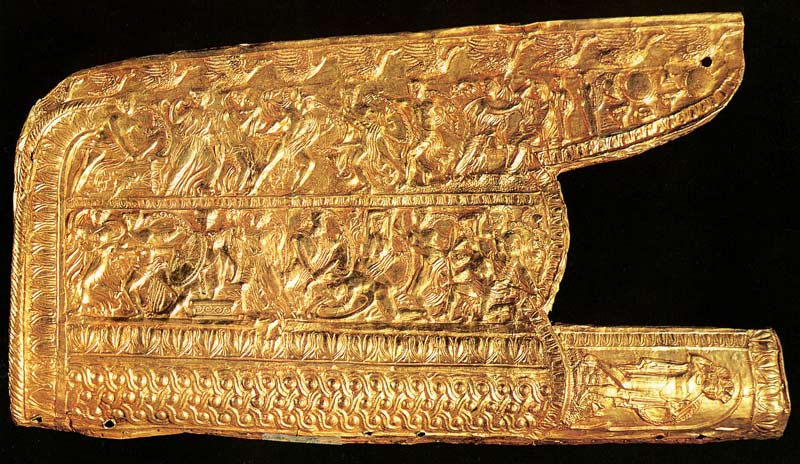
 Attachment: 94.48 KB
Attachment: 94.48 KB
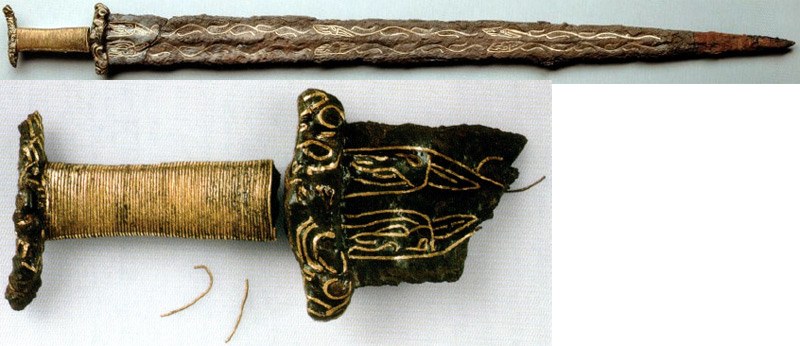
Great thread.
I have a couple of images that may be of interest. The first is a Quiver found in the tholos burial at Vergina... believed to be the tomb of Philip II of Macedon. I have read that some scholars think it may be a gift or trophy from Scythian lands.
The second is a sword published in The Metropolitan Museums work called "The Golden Deer of Eurasia." It is said to date from the 4th century B.C. I am amazed at how the guard has characteristics of later scandinavian swords, particularly Peterson's type Z.
take care
ks


Page 1 of 2
You cannot post new topics in this forumYou cannot reply to topics in this forum
You cannot edit your posts in this forum
You cannot delete your posts in this forum
You cannot vote in polls in this forum
You cannot attach files in this forum
You can download files in this forum
All contents © Copyright 2003-2006 myArmoury.com — All rights reserved
Discussion forums powered by phpBB © The phpBB Group
Switch to the Full-featured Version of the forum
Discussion forums powered by phpBB © The phpBB Group
Switch to the Full-featured Version of the forum